 |
||
|
||
| ||
New technological solutions attract attention not only of potential buyers but also of the press. The Nokia 7650 is the first device working under the Symbian OS and equipped with an integrated digital camera from the very beginning; that is why some gave it a name of cameraphone. In my opinion, this name doesn't reflect its idea: the Nokia 7650 is exactly a smartphone, and a smartphone can include a camera as well. 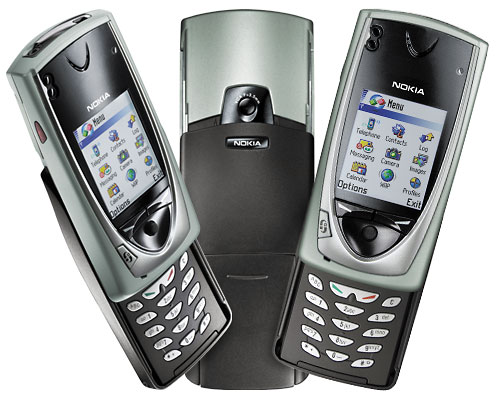 The Nokia Communicator available on the market before also worked under the Symbian OS and had a digital camera as a separate module. But it's wrong to compare these two devices: the 9210 has a normal keyboard, a slot for MMC memory cards in addition to the internal memory of the smartphone. The Nokia 7650 doesn't have such things - just a simple key-pad. As a result, these devices differ in dimensions: the Nokia 9210 (158 x 56 x 27 mm) can't be worn in shirt or jeans pockets, while the Nokia 7650 (114 x 56 x 26 mm) can easily fit your breast pocket. When the keyboard is open, the 7650 measures as much as the 9210. But the new model weighs 154 g against 244 g of the 9210.  The opening mecahnism of the new smartphone is worth a special attention. The keyboard and the battery are located below, and all the rest is above. The parts are connected with rails. It's quite difficult to move the parts to open or close the phone. That is why I'm sure the mechanism won't weaken with time.  To open the keyboard you should either pull the rear part or press your thumb against the upper part and push it. The second method is preferable as you do it with just one hand. You can also try to shake the phone well holding its keyboard - this model lacks for any backlash. When the phone is opened, only the half of the rear part juts out, which makes the construction less fragile. You can close the phone placing it on a hard surface and pushing it down. There are no mechnisms that would fix the phone to prevent its opening, but it's unlikely that it will open accidently. The keyboard is made of plastic; the keys are quite small but it's convenient to press them. The dimensions of the phone allow working with it with both hands, which is quite unusual, but it speeds up text input considerably. When your are closing it the device asks whether to lock the keyboard. Of course, it concerns only several keys on the upper panel. By the way, when you open the device the keyboard unlocks automatically. The battery compartment is covered with a pastic lid which is much less reliable than other elements of the construction: the tested sample has backlash in all directions, but you feel it only when pressing the thumb down the lid. I think the backlash is caused by a vertical position of the holder. The lid also supports the juts above, but it is far not enough. Under the cover you can reveal a rechargeable battery, which is inherited yet from BLB-2 models. This is a Li-Ion battery of 750 mAh. According to the manufacturer, this battery provides 2 - 4 hours in the talk mode and 90 - 230 hours in the standby one. The phone actually works three days in case of 10 minutes of talking and 15 minutes of using different applications a day. Without talks the time increases up to 5 days (15 - 30 minutes a day). It takes hour and a half for the battery to recharge. The connector for a charger is on the lower panel; any other interface connectors are lacking. Unfortunately, you can't use a battery of increased capacity because these model works only with BLB-2. Now let's turn to the upper part. The 7650 uses a TFT matrix (not touch-sensitive) with up to 4096 colors and measuring 35x41 mm at 176x208 pixels. Photos made with the integrated camera look excelent on the screen; it also concerns the menu and programs. In a too sunny weather the image is less sharp, but it is still easy to read information on the screen. Contrast can undoubtedly be adjusted; there is also a light sensor with two backlight parameters (minimal and maximum). It seems to me that the energy-saving mode is always activated outdoors, while idoors the illumination level is maximum. The sensor (a small white circle) is located on the upper right. The backlight doesn't work in the standby mode, but you still can adjust the clock or date.    To the left of the screen there are two a bit recessed circles - this is a distance sensor. In the handsfree mode it reacts to objects: if you carry it to your ear or just pass your hand over it it will switch into the usual mode - this is the simplest "fool protection" used before in some phones. Above the screen are two functional keys. Between them is a rubber joystick which is very easy to handle: apart from moving in four directions you can also press it, which allows controlling the phone with one hand - from the ergonomic standpoint the Nokia 7650 is one of the best devices in the world. On the front panel there is also one menu button - press it once and you will get into the general menu, press it twice and you will see a list of started-up applications so that you can switch from one to another. The right panel has a power button. In the standby mode you can use it to change a profile, lock the keyboard or phone. The left panel has a voice dialing button which also supports a handsfree mode. The upper panel hides an IR port and a headset jack. To insert a SIM card you must open the device, pull the plastic upper part and you will see a respective connector. By the way, the plastic lid covering the SIM holder also has some backlash.  The camera is quite simple: the focal range is 3.5 mm, no auto focusing is provided, but I expected that. The scrren is used as a viewfinder, which is quite convenient. The phone comes which a special Camera program. It allows you to give default names to image files, choose quality for shooting etc. A file of 33 KBytes, 640x480, is recorded directly in JPG. Quality of shots made with minimal compression (High in the menu) can be considered ideal for the 7650's screen. There are three shooting modes: Normal, Portrait (80x96) and Night. In the latter case the lightsensitivity of the matrix is forcedly increased, which results in a higher noise level of the photo and its size. I think that the standard mode is optimal in most cases, even indoors without much light. The number of photos depends on free memory: the highest quality allows for a bit over 40 shots, a part of which then should be deleted or moved to a PC. The tested sample has a vertical resolution lower than a horizontal one. It is either a problem of the matrix or it's a defective plastic lens. But remember that the camera is just an additional feature, and it can't replace a normal camera because of quality. And now look at several photos made in different light conditions - they look best of all (photo1, photo2, photo3). MenuThe Nokia 7650 works under the Symbian OS and has a respective graphics interface. The screen shows you a Phone application, above is a signal level (7 points), time and date (analog or digital clock), provider's name, battery status (7 points), icons of different modes. And below there are two soft keys - Camera and Contacts at default. But you can assign other applications for them. On the whole, the range of settings is quite wide. For example, any image can be used as wallpaper, the clock or a reminder can be used as a screensaver.  Press the menu button located on the front panel and you will get into the general menu, where you will see icons or a list of applications; navigations is carried out with a joystick, an application can be selected by pressing it. Everything is simple and handy. Before we turn to applications, let me dwell on localization and memory the size of which is just 4 MBytes and can't be extended. If you are not going to install great many additional applications, this size is enough for most tasks of the smartphone. However, the experience shows (I mean the 9210) that the release of the 7650 will be followed by a lot of interesting games and business programs. The CD coming with the 7650 contains PC Suite for Nokia 7650 and analog packets in 28 languages. You can install only two additional packets simultaneously (English is default). By the way, the PC Suite for Nokia 7650 allows looking through the contents of directories, backing up data, creating directories, installing additional applications etc. All these things can be implemented via a bluetooth or IR connection because there is no any cables. Now let's take a look at the main applications installed at default. Contacts. The phone book allows for almost any number of entries; they are limited only by the memory. For one contact you can record a name and a surname, company's name, job title, phone number, mobile phone number, fax and e-mail address - 8 fields in all. You can't add anything more over it. But for each contact you can write a short note, put in a photo which will be displayed in case of a respective incoming call. Besides, any field can be renamed, for example, it's possible to rename job title into date of birth. 25 contacts in the phone book can have voice marks (the function works flawlessly, no recorgnition problems). 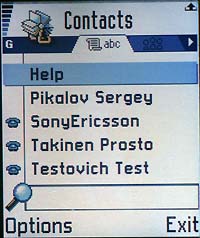    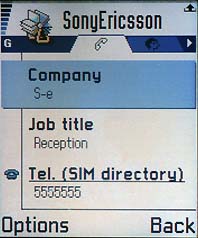 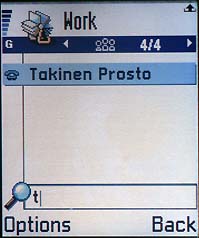  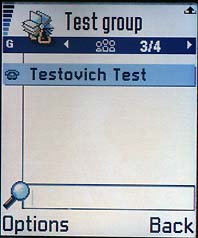  It's interestiong that for each contact you can set a default phone number, MMS number, e-mail address, which makes an address search much easier, for example, when creating an MMS message. There are also groups of subscribers for which you can assign a group ring signal. One subscriber can be recorded into several groups simultaneously. The standard software allows for nothing more. In general, the phone book in the Nokia 7650 is undoubtedly more advanced than in usual cell phones, but it is much simpler as compared with a record book in PDAs. The 7650 is, in fact, the first device in its class, and many applications have still a long way to go. In any list (contacts, list of messages etc.) you can choose all records from the menu at once or select those you need by pressing the ABC button and the joystick. Unfortunately, you can't send all the contacts this way - you can just delete them all. To send an entry to another phone or PDA you must select it and choose a sending type. Note that the 7650 supports the SyncML technology. Log. This menu opens access to the lists of calls missed, received and dialled; the time period for the records to be stored is for you to determine (a month at default). Each call has a type (voice, data), duration, date, time and number displayed. Calls can be filtered according to their types (data, GPRS, voice, incoming, outgoing, messages). The menu also calculates duration and cost of calls. By the way, a call's duration is shown on a screen while you are speaking. Messaging. Apart from standard short messages you can create an MMS and send/receive your mail (POP3/IMAP4/SMTP). The post client of the 7650 is almost the same as on the 9210. You can create templates for any messages, and there are 10 templates already available for SMS. I won't descibe all functions, just want to note that I faced no problems with settings. In the Bee Line network MMS messages were successfully transferred from one phone to another, also 7650, but an attempt to send an MMS to the SonyEricsson T68i failed, because the phones have different capabilities in displaying images, i.e. they are incompatible on this level.  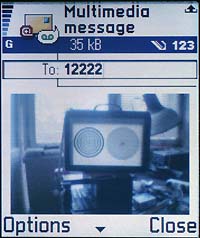 Camera. Thsi application was described earlier. Calendar. This is the second important application for a smartphone. The 7650 supports several ways of looking through the calendar - by day (shows a day's schedule), week or month. Only three event types are supported: Meeting, Memo and Anniversary. For each you can set a warning signal. The organizer is quite scarce - there are no settings or means for working with events! 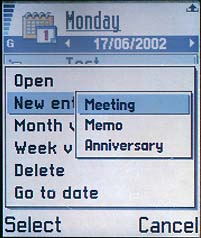   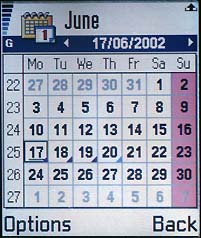  Images. This application stores images made with the camera. Photos are displayed as miniatures, each of which can be enlarged or turned. The photos look excellent on the screen.    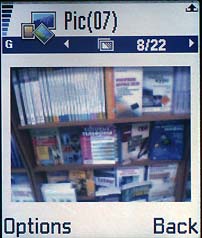 Services. The Wap browser is of the 1.2.1 version, though I think the 2.0 version would be a better choice. Profiles. This option is identical to that of usual phones.  Favourites. You can create a label for almost any file (message, image, sound) to put it into the Favorites folder. 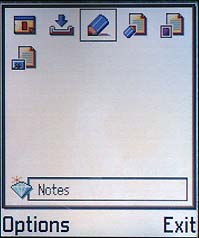 To-do. This is a usual to-do list for the events of which you can set a data and a name, one of three priorities or tick events off.  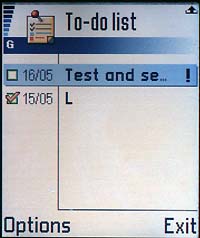 Connectivity. All connection settings are stored here, including settings of the modem, IR port and bluetooth which has remained an internal function of the Nokia devices. An attempt to adjust the device, so that it connects the Ericsson's headset automatically, failed: both bluetooth connection and phone talks got broken from time to time. Extras. This menu contains several applications: notes, simple text files (which are created by a user), a cute calculator, a converter, a dictaphone, a composer and a clock. The latter item includes alarm settings: the alarm clock can be set only for a definite time and it excludes any recurring events. Remember that installed Java applications are placed into the Extras menu befind the Apps icon.      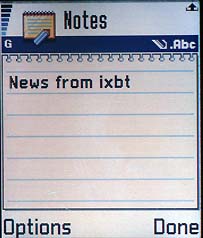  SIM. The 7650 lacks for integration of numbers from the SIM card with the phone book, that is why if you want to use numbers from the SIM card you have to copy them into the Contacts. 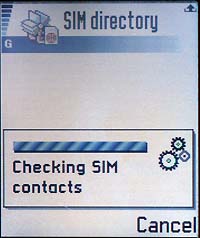  Tools. This folder contains all possible tools. Some were already mentioned earlier, the only thing I have to add is an application manager that installs them and shows what is already installed and how much memory is taken.  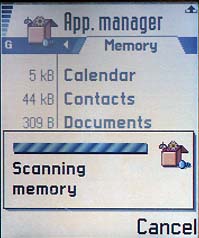  Games. The phone comes with three games: Snake Ex, Card Deck and Mix Pix. ImpressionsAs far as sound transfer is concerned, the 7650 is a standard phone comparable withm for example, Nokia 6310, 8310. The sound is heard excellently, the speakerphone mode is realized perfectly, though you will hardly be able to use it in a noisy room. The advantage of the phone is that duration of talks is displayed, the disadvantage is that it's impossible to activate the dictaphone with one touch. Another peculiarity of the phone is a signal produced every 5 seconds, which starts irritating with time. The vibracall is average: you won't feel it if the phone is in your bag. The ring is loud, clear and nonpolyphonic. On the whole, the phone has the following advantages: quite small dimensions, a built-in camera with acceptable photo quality, a good screen. And disadvantages: operating time is low, it's impossible to use a more capacious battery, drawbacks in the bluetooth realization and lack of a cable and additional expansion cards. 4 MBytes of the memory doesn't allow for many interesting programs written for the Symbian. The software is rather ascentic and is worse than that of an average PDA, though it provides more capabilities than an average mobile phone. A great downside of the device is that with no SIM card installed you can use none of its functions. I think it is a marketing policy: if the 7650 were equipped with an expansion slot, the sales of the 9210i would quickly fall down. Although the price difference is considerable, the 7650 is a better purchase because far not everyone needs a normal keyboard: a lot of users input texts using a PC and use a smartphone just for reading. On the one hand, this model has excellent ergonomics and a handy menu, but on the other hand, the functionality is greatly limited. I think the 7650 will sell excellently until a new device of such class appears on the market (for example, SonyEricsson P800). Everything will depend on how soon a competitor comes out onto the market: if it will happen within a month or two and such device will be produced in mass, the 7650 will face some problems (the P800, for example, has much more functions, in particular, it has a slot for memory cards). Nokia says the 7650 will appear in Europe by the middle of July at about
$700.
Write a comment below. No registration needed!
|
Platform · Video · Multimedia · Mobile · Other || About us & Privacy policy · Twitter · Facebook Copyright © Byrds Research & Publishing, Ltd., 1997–2011. All rights reserved. |